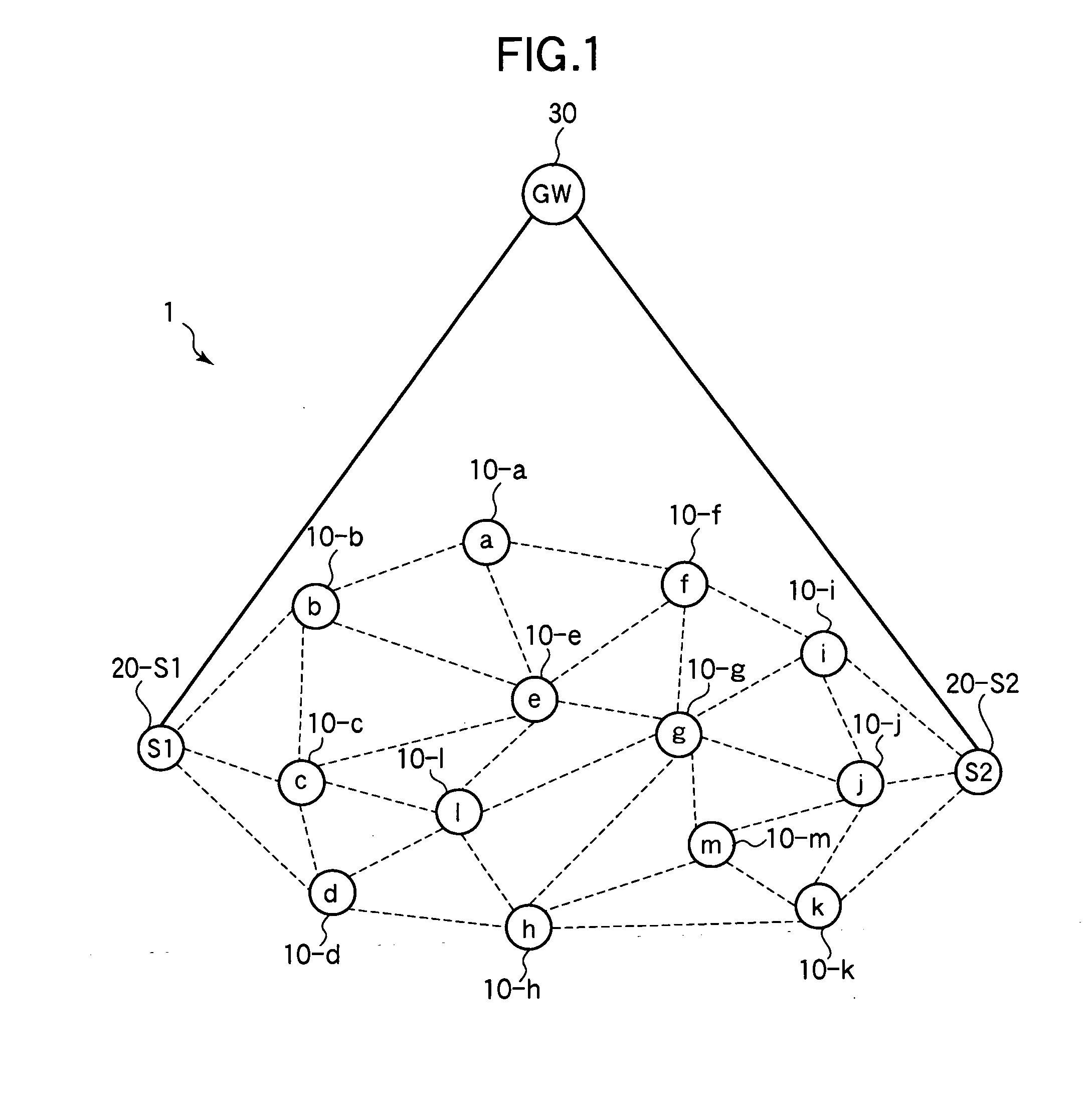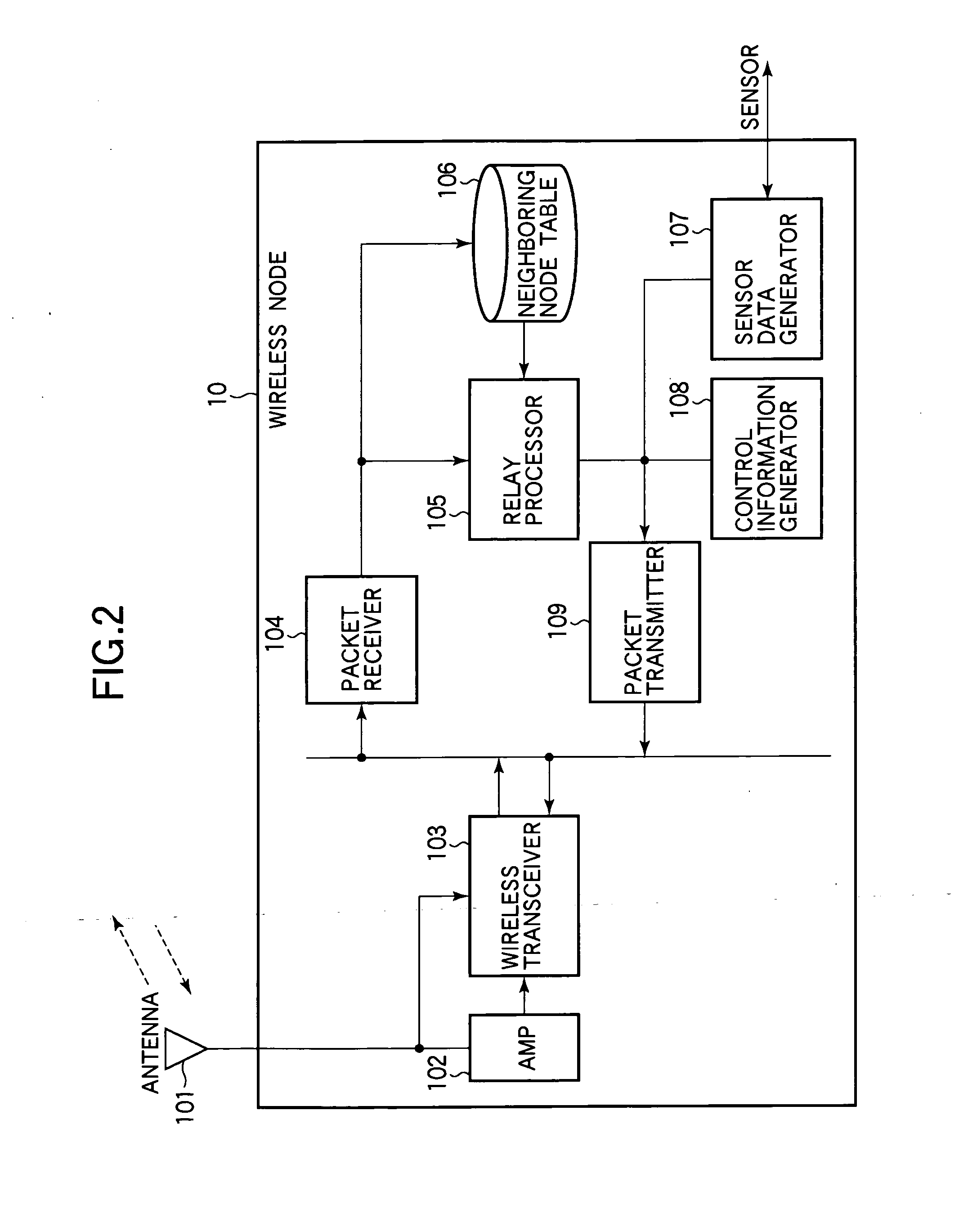Wireless communication system and nodes
a wireless communication and wireless communication technology, applied in the field of multi-hop wireless communication system, can solve the problems of increasing the amount of network traffic used for relaying rreq commands, no ready way to detect, and no data communication throughput of the network suffers correspondingly
- Summary
- Abstract
- Description
- Claims
- Application Information
AI Technical Summary
Benefits of technology
Problems solved by technology
Method used
Image
Examples
first embodiment
[0042]Referring to FIG. 1, the first embodiment is a wireless communication system 1 including wireless nodes 10-a to 10-m, a pair of sink nodes 20-S1 and 20-S2, and a gateway (GW) 30. For brevity, reference numeral 10 will be used when it is not necessary to identify the wireless nodes individually, and reference numeral 20 when it is not necessary to identify the sink nodes individually.
[0043]The gateway 30 is connected by a wireline network to the two sink nodes 20. In the following description, each sink node 20 has a direct wireline link to the gateway 30, as shown. In general, the wireline network may include intermediate nodes (not shown) between the gateway 30 and sink node 20. The sink nodes 20 function as relay nodes through which the wireless nodes 10 are connected to the gateway 30.
[0044]The wireless nodes 10 form a multi-hop sensor network. Each wireless node 10 acquires data from a sensor (not shown), and sends the data through one of the sink nodes 20 to the gateway 3...
second embodiment
[0088]Referring to FIG. 9, the wireless communication system 1A in the second embodiment includes a gateway 30A and five sink nodes 20-S1, 20-S2, 20-S3, 20-S4, 20-S5. A plurality of wireless nodes 10A are connected to each sink node 20.
[0089]Referring to FIG. 10, the gateway 30A includes a wireline transceiver 301, a packet receiver 302, a downstream path table 303, and a packet transmitter 304, which operate substantially as described in the first embodiment, and a newly added failure detector 305 and failure notifier 306.
[0090]The failure detector 305 detects failures of the sink nodes 20. When a failure is detected, the failure notifier 306 generates a control packet referred to below as a failure notification packet and sends it via the packet transmitter 304 and active sink nodes 20 to the wireless nodes 10A.
[0091]Next the operation of the second embodiment will be described, starting from the state depicted in FIG. 9.
[0092]At regular intervals, the failure detector 305 in the ...
third embodiment
[0105]The third embodiment is similar to the second embodiment but employs modified wireless nodes.
[0106]Referring to FIG. 15, each of the wireless nodes 10B in the third embodiment is generally similar to the wireless nodes in the preceding embodiments but includes an additional control information buffer 111 disposed between the control information generator 108 and the packet transmitter 109. When the control information generator 108 generates a packet such as an RREC packet to be sent to the gateway 30A or to a sink node 20 to establish a downstream path, the control information buffer 111 may store the packet for a prescribed time before passing the packet to the packet transmitter 109. The prescribed time may be fixed or variable.
[0107]The third embodiment operates in the same way as the second embodiment except for the transmission of Hello packets following a change of route to the gateway 30A. The following description will therefore focus on the process following the tran...
PUM
 Login to View More
Login to View More Abstract
Description
Claims
Application Information
 Login to View More
Login to View More - R&D
- Intellectual Property
- Life Sciences
- Materials
- Tech Scout
- Unparalleled Data Quality
- Higher Quality Content
- 60% Fewer Hallucinations
Browse by: Latest US Patents, China's latest patents, Technical Efficacy Thesaurus, Application Domain, Technology Topic, Popular Technical Reports.
© 2025 PatSnap. All rights reserved.Legal|Privacy policy|Modern Slavery Act Transparency Statement|Sitemap|About US| Contact US: help@patsnap.com



